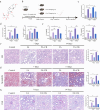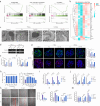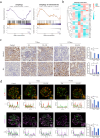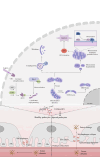Protective effect of compound K against podocyte injury in chronic kidney disease by maintaining mitochondrial homeostasis
- PMID: 39748100
- PMCID: PMC11696807
- DOI: 10.1038/s41598-024-84704-6
Protective effect of compound K against podocyte injury in chronic kidney disease by maintaining mitochondrial homeostasis
Abstract
Chronic kidney disease (CKD) stands as a formidable global health challenge, often advancing to end-stage renal disease (ESRD) with devastating morbidity and mortality. At the central of this progression lies podocyte injury, a critical determinant of glomerular dysfunction. Compound K (CK), a bioactive metabolite derived from ginsenoside, has emerged as a compelling candidate for nephroprotective therapy. Here, we unveil the profound therapeutic potential of CK in a folic acid (FA)-induced CKD mouse model, demonstrating its ability to restore renal function and mitigate podocyte injury. CK exerted its nephroprotective effects by reinforcing inter-podocyte junctions, suppressing aberrant podocyte motility, and preventing podocyte detachment and apoptosis, thereby safeguarding the glomerular filtration barrier. Mechanistically, we identified mitochondrial dysregulation as a key driver of excessive oxidative stress, which is commonly associated with podocyte damage. CK remarkably restored mitochondrial homeostasis by attenuating pathological mitochondrial fission and enhancing mitophagy, thereby rebalancing the delicate mitochondrial network. Intriguingly, CK may disrupt the formation of the Drp1-Bax dimer, a crucial mediator of mitochondrial apoptosis, further averting podocyte loss. Collectively, our findings highlight CK as a potent nephroprotective agent, offering a novel therapeutic avenue for CKD management and redefining possibilities in the battle against progressive renal disease.
Keywords: Apoptosis; Chronic kidney disease; Compound K; Mitochondrial homeostasis; Podocyte Injury.
© 2024. The Author(s).
Conflict of interest statement
Declarations. Competing interests: The authors declare no competing interests. Declaration of competing interest: The authors declare that they have no conflicts of interest. Ethics statement: All experiments involving animals have been approved by the Institutional Animal Care and Use Committee of Zhejiang Chinese Medical University (the approval number of ethics committee: IACUC-20240429-16). All animal procedures were adhered to internationally accepted standards for animal research, following the 3Rs principle. The ARRIVE guidelines were employed for reporting experiments involving live animals, promoting ethical research practices.
Figures






Similar articles
-
p53/Drp1-dependent mitochondrial fission mediates aldosterone-induced podocyte injury and mitochondrial dysfunction.Am J Physiol Renal Physiol. 2018 May 1;314(5):F798-F808. doi: 10.1152/ajprenal.00055.2017. Epub 2017 Jun 28. Am J Physiol Renal Physiol. 2018. PMID: 28659272
-
Ginsenoside Compound K Mitigates Mitochondrial Fission Through Bile Acid Receptors/YAP Signaling to Counteract Podocyte Injury in Lupus Nephritis.Phytother Res. 2025 Jun 18. doi: 10.1002/ptr.8492. Online ahead of print. Phytother Res. 2025. PMID: 40528637
-
Mitochondria-targeting therapeutic strategies for chronic kidney disease.Biochem Pharmacol. 2025 Jan;231:116669. doi: 10.1016/j.bcp.2024.116669. Epub 2024 Nov 27. Biochem Pharmacol. 2025. PMID: 39608501 Review.
-
Mitochondrial Dysfunction: The Silent Catalyst of Kidney Disease Progression.Cells. 2025 May 28;14(11):794. doi: 10.3390/cells14110794. Cells. 2025. PMID: 40497970 Free PMC article. Review.
-
Oxysterol-binding protein-like 7 deficiency leads to ER stress-mediated apoptosis in podocytes and proteinuria.Am J Physiol Renal Physiol. 2024 Sep 1;327(3):F340-F350. doi: 10.1152/ajprenal.00319.2023. Epub 2024 Jul 4. Am J Physiol Renal Physiol. 2024. PMID: 38961844
Cited by
-
Targeted Modulation of Mitochondrial Oxidative Stress Ameliorates 5-Fluorouracil-Induced Renal Injury in BALB/c Mice.Oxid Med Cell Longev. 2025 Mar 6;2025:8892026. doi: 10.1155/omcl/8892026. eCollection 2025. Oxid Med Cell Longev. 2025. PMID: 40225412 Free PMC article.
-
Chronic changes developing in the hydronephrotic and contralateral kidneys during unilateral ureteral obstruction in rats.Mol Biol Rep. 2025 Apr 22;52(1):413. doi: 10.1007/s11033-025-10486-3. Mol Biol Rep. 2025. PMID: 40261471
-
Modulation of podocyte extracellular matrix remodeling in membranous nephropathy by the NFATc3/LRRC55/BK channel pathway.J Cell Commun Signal. 2025 Jun 13;19(2):e70022. doi: 10.1002/ccs3.70022. eCollection 2025 Jun. J Cell Commun Signal. 2025. PMID: 40520074 Free PMC article.
References
Publication types
MeSH terms
Substances
Grants and funding
- No. 2022YKJ03/the Zhejiang Chinese Medicine University Postgraduate Scientific Research Fund Project
- No. 81803980/Discipline Construction Project of Zhejiang Chinese Medical University, the National Natural Science Foundation of China
- No. 2022JKZZW03/the Research Project of Zhejiang Chinese Medical University
- 2020ZG09/the Research Project of Zhejiang Chinese Medical University
LinkOut - more resources
Full Text Sources
Medical
Research Materials
Miscellaneous

